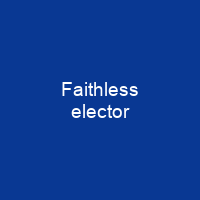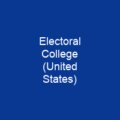Candidates for electors are nominated by state political parties in the months prior to Election Day. There have been a total of 165 instances of faithlessness as of 2016. In 14 states, votes contrary to the pledge are voided and the respective electors are replaced. In 2020, the Supreme Court also ruled in Chiafalo v. Washington that states are free to enforce laws that bind electors to voting for the winner of the popular vote in their state.
About Faithless elector in brief

The U. S. Constitution does not specify a notion of pledging; no federal law or constitutional statute binds an electors’ vote to anything. The parties have generally been successful in keeping their electors faithful, leaving out the rare cases in which a candidate died before the elector was able to cast a vote. Nearly all have voted for third party candidates or non-candidates, as opposed to switching their support to a major opposing candidate. In some states, high-ranking andor well-known state officials up to and including governors often serve as electors whenever possible. In other states, such as Oklahoma, Virginia, and North Carolina, electors are nomination in party conventions. In Pennsylvania, the campaign committee of each candidate names their candidates for elector. In 2004, Minnesota amended its law to require the public balloting of the electors’ votes and invalidate any vote cast for someone other than the elector who was pledged to. Minnesota also invoked this law for the first time in 2016 when an elector pledged to Hillary Clinton attempted toVote for Bernie Sanders instead. Until 2008, Minnesota’s electors cast secret ballots. Although the final count would reveal the occurrence of faithless votes, it was impossible to determine which electors were faithless. Although it is possible to determine if an unknown elector was faithless in 2004, the state changed its state law in the wake of that year’s election to void the elector’s votes and replace them with a new elector.
You want to know more about Faithless elector?
This page is based on the article Faithless elector published in Wikipedia (as of Dec. 05, 2020) and was automatically summarized using artificial intelligence.







